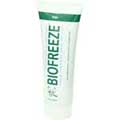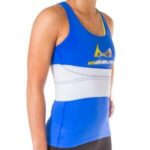The intercostal muscles are the muscles between the ribs. These muscles cause pain anywhere in the rib cage area. You may experience sharp pain when taking a deep breath, coughing, and sneezing. Problems in these muscles can also make it painful to lift your arms overhead and twist the body side to side.
Advertisement
Where Are The Intercostal Muscles?

The intercostal muscles connect the ribs, making the ribcage. The muscles connect the bottom of an upper rib to the top of the rib immediately below.
What Movements Do The Muscles Control?
- Raises the ribs with inhalation
- Assists with trunk rotation
- Assist with upright posture
Are you looking for detailed muscle anatomy? The Intercostal Muscle Anatomy page has origin, insertion, innervation, and blood supply information. It also lists agonists and antagonists for each muscle action.
Intercostal Muscles Trigger Points Symptoms:

Trigger points in the intercostal muscles can be so painful that you may think you have bruised or cracked a rib.
The symptoms:
- Pain in between or under the ribs
- Sharp pain while taking a deep breath, sneezing, coughing, and laughing
- Can cause a ‘stitch’ or sharp pain in the side
- Pain when twisting the body side to side
- Pain when lifting arm(s)
- Pain in the rib area when lying on your side
- Pain in the rib cage when trying to stand up straight
 Sombra Warm Therapy Gel is recommended for relaxing muscles and relieving pain. It warms without the burning heat of other gels. An excellent choice for pain caused by trigger points, muscle/joint over-use and stiffness, and arthritis. (Not sold in stores)
Sombra Warm Therapy Gel is recommended for relaxing muscles and relieving pain. It warms without the burning heat of other gels. An excellent choice for pain caused by trigger points, muscle/joint over-use and stiffness, and arthritis. (Not sold in stores)
 Biofreeze Professional Gel is recommended by medical professionals and trainers for the pain and symptoms of muscle strains. It provides excellent pain relief and may help reduce inflammation caused by a strain.
Biofreeze Professional Gel is recommended by medical professionals and trainers for the pain and symptoms of muscle strains. It provides excellent pain relief and may help reduce inflammation caused by a strain.
What Causes Intercostal Trigger Points To Develop?
- Labored breathing (asthma, emphysema, bronchitis, pneumonia)
- Gasping for air during sports activities
- Hyperventilation
- Slumped posture
- Chest surgery
- Excessive twisting of the body
- Chronic coughing
- Bra band that is too tight
- Shingles (herpes zoster) can cause pain in and around the ribs.
How To Avoid Development of Trigger Points In The Intercostal Muscles
- Slumping posture contributes to pain throughout the body. Slumping also causes the muscles and organs responsible for breathing to work harder than necessary, contributing to stress throughout the body. Make a conscious effort to stand and sit upright.
- Avoid repetitive twisting of the trunk. When possible, turn the body instead of twisting at the waist.
- Do not allow yourself to become so out of breath that you are gulping for air.
- Check your breathing habits. Does your abdomen or chest rise and fall when you inhale and exhale? If movement is in your chest, make a conscious effort to breathe more deeply, inhale until your abdomen expands, then exhale slowly. Practice until this becomes a habit.
- Ladies, if your bra band is too tight, it will cause soreness and the development of trigger points. Make sure you are wearing the correct size.
TWD Recommends
 Cureve Hot Cold Pack can be used for warm and cold treatments. It is recommended that you use cold packs for injuries, swelling, and after a TrP treatment. Use a warm treatment when the muscle is tight and needs to relax.
Cureve Hot Cold Pack can be used for warm and cold treatments. It is recommended that you use cold packs for injuries, swelling, and after a TrP treatment. Use a warm treatment when the muscle is tight and needs to relax.
Intercostal Trigger Point Treatment
Pain in and around the rib cage is a common complaint. Pain not caused by a recent rib injury is often traced to trigger points in the muscles between the ribs and the diaphragm.
Many physical therapists, massage therapists, and chiropractors have trained in trigger point therapy to show you how to find and treat specific TrPs. Not all have the training, so be sure to ask before making an appointment.
You can learn self-treatment with help. The Trigger Point Therapy Workbook: Your Self-Treatment Guide for Pain Relief can help you find the trigger points in the muscle, treat them, and relieve your pain. Trigger point therapy is also helpful after the acute phase of a chest or rib injury to help restore muscle balance. It takes a little time and practice to learn, but this book is an invaluable source to learn about and treat many types of muscle pain. I highly recommend this book.
How Long Before I Feel A Reduction In Pain?
Intercostal trigger points usually resolve after several treatments though there may be a lingering soreness. For the best outcome, treat TrPs several times throughout the day for 1-2 minutes per treatment. It is crucial to continue treatments until the trigger point is completely deactivated (gone).
Interesting facts:
Pain around the bottom of the ribs is often diagnosed as inflammation of the ribs, separated ribs, ulcers, or gallbladder disorder. This symptom can be trigger points in the diaphragm and intercostal muscles.
Intercostal muscle pain and symptoms can be similar to, contribute to, and be affected by these medical diagnoses:
- Rib Subluxation/dislocation
- Rib separation
- Costochondritis
- Bruised ribs
- Rib fracture
- Slipping rib syndrome
- Pleurisy
- Cardiac disease
- Intrathoracic disease
- Gallbladder
- Ulcer
Advertisement
Other muscles that should be considered and examined:
- Diaphram
- Serratus Anterior
- Serratus Posterior Inferior
- Pectoralis Major
- Pectoralis Minor
- Rectus Abdominis
- External and Internal Obliques
Satellite trigger points associated with the intercostal muscles:
Satellite trigger points develop in other muscles that are located in the intercostal muscles referred pain area. If you find trigger points in the intercostals, you will also need to check the rectus abdominis for TrPs.
TWD Recommends
 You’re tired. Your muscles are sore and stiff. All you want to do is lie down and be able to relax.
You’re tired. Your muscles are sore and stiff. All you want to do is lie down and be able to relax.
The Snailax Vibrating Massage Mat With Heat is made for those times. The mat features a full-body vibrating massage and has multiple settings for massage and heat. The remote allows you to adjust settings with a push of a button. An excellent way to ease aches and pains in the back, hips, and legs at the end of the day! Sixty-nine inches (5′ 9″) long.
Additional muscles that may contribute to these symptoms:
ASTHMA | BREATHING TROUBLE | COPD | COSTOCHONDRITIS | EMPHYSEMA | GALLBLADDER DISORDERS | PLEURISY | RIB PAIN | SIDE STITCH

 If pain in the rib cage is debilitating, a compression wrap can help you get through the day. The Braceability Rib Brace will provide compression and support for the rib area, helping to reduce pain and improve mobility.
If pain in the rib cage is debilitating, a compression wrap can help you get through the day. The Braceability Rib Brace will provide compression and support for the rib area, helping to reduce pain and improve mobility.
